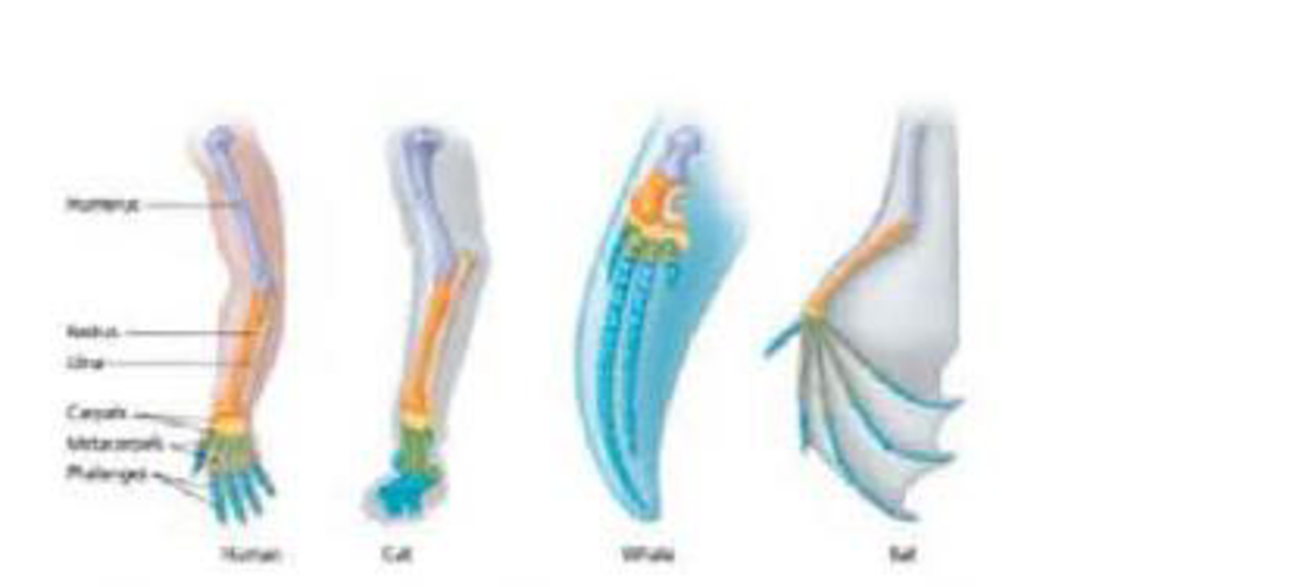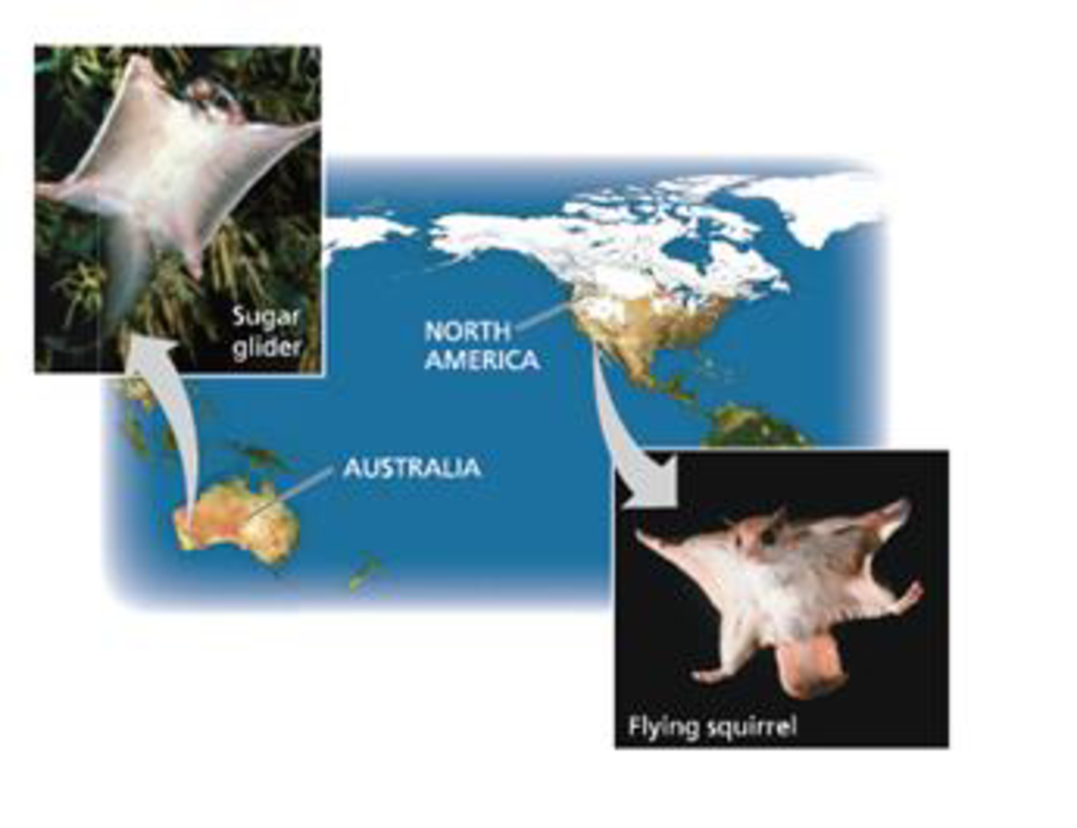
CAMPBELL BIOLOGY IN FOCUS-TEXT,AP ED.
3rd Edition
ISBN: 9780136811206
Author: Urry
Publisher: SAVVAS L
expand_more
expand_more
format_list_bulleted
Concept explainers
Textbook Question
Chapter 19.3, Problem 2CC
How does evolution account for (a) the similar mammalian forelimbs with different functions shown in Figure 19.16Q and (b) the similar forms of the two distantly related mammals shown in Figure 19.18Q?

Figure 19.16 Mammalian forelimbs: homologous structures.

Figure 19.18 Convergent evolution.
The ability to glide through the air evolved independently in these two distantly related mammals.
Expert Solution & Answer
Want to see the full answer?
Check out a sample textbook solution
Students have asked these similar questions
What are biofertilizers and mention the significance
PCBs and River Otters: Otters in Washington State’s Green-Duwamish River have high levels of polychlorinated biphenyls (PCBs) in their livers. PCBs can bind to the estrogen receptors in animals and disrupt the endocrine system of these otters. The PCBs seem to increase the estrogen to androgen ratio, skewing the ratio toward too much estrogen.
How would increased estrogen affect the river otter population?
Based on your reading of the materials in this unit, what factors can affect fertility in humans?
Explain how each of the factors affecting human fertility that you described can disrupt the human endocrine system to affect reproduction.
Other than oil and alcohol, are there other liquids you could compare to water (that are liquid at room temperature)?
How is water unique compared to these other liquids?
What follow-up experiment would you like to do, and how would you relate it to your life?
Chapter 19 Solutions
CAMPBELL BIOLOGY IN FOCUS-TEXT,AP ED.
Ch. 19.1 - How did Huttons and Lyells ideas influence Darwins...Ch. 19.1 - MAKE CONNECTIONS Scientific hypotheses must be...Ch. 19.2 - How does the concept of descent with modification...Ch. 19.2 - Prob. 2CCCh. 19.2 - MAKE CONNECTIONS Review the relationship between...Ch. 19.3 - Explain how the following statement is inaccurate:...Ch. 19.3 - How does evolution account for (a) the similar...Ch. 19.3 - WHAT IF? Fossils show that dinosaurs originated...Ch. 19 - Which of the following is not an observation or...Ch. 19 - Which of the following observations helped Darwin...
Ch. 19 - Prob. 3TYUCh. 19 - The upper forelimbs of humans and bats have fairly...Ch. 19 - DNA sequences In many human genes are very similar...Ch. 19 - SCIENTIFIC INQUIRY DRAW IT Mosquitoes resistant to...Ch. 19 - FOCUS ON EVOLUTION Explain why anatomical and...Ch. 19 - FOCUS ON INTERACTIONS Write a short essay (about...Ch. 19 - SYNTHESIZE YOUR KNOWLEDGE This honeypot ant (genus...
Additional Science Textbook Solutions
Find more solutions based on key concepts
What process causes the Mediterranean intermediate Water MIW to become more dense than water in the adjacent At...
Applications and Investigations in Earth Science (9th Edition)
Why do scientists think that all forms of life on earth have a common origin?
Genetics: From Genes to Genomes
True or false? Some trails are considered vestigial because they existed long ago.
Biological Science (6th Edition)
Gregor Mendel never saw a gene, yet he concluded that some inherited factors were responsible for the patterns ...
Campbell Essential Biology (7th Edition)
To test your knowledge, discuss the following topics with a study partner or in writing ideally from memory. Th...
HUMAN ANATOMY
Single penny tossed 20 times and counting heads and tails: Probability (prediction): _______/20 heads ________/...
Laboratory Manual For Human Anatomy & Physiology
Knowledge Booster
Learn more about
Need a deep-dive on the concept behind this application? Look no further. Learn more about this topic, biology and related others by exploring similar questions and additional content below.Similar questions
- Selection of Traits What adaptations do scavengers have for locating and feeding on prey? What adaptations do predators have for capturing and consuming prey?arrow_forwardCompetition Between Species What natural processes limit populations from growing too large? What are some resources organisms can compete over in their natural habitat?arrow_forwardSpecies Interactions Explain how predators, prey and scavengers interact. Explain whether predators and scavengers are necessary or beneficial for an ecosystem.arrow_forward
- magine that you are conducting research on fruit type and seed dispersal. You submitted a paper to a peer-reviewed journal that addresses the factors that impact fruit type and seed dispersal mechanisms in plants of Central America. The editor of the journal communicates that your paper may be published if you make ‘minor revisions’ to the document. Describe two characteristics that you would expect in seeds that are dispersed by the wind. Contrast this with what you would expect for seeds that are gathered, buried or eaten by animals, and explain why they are different. (Editor’s note: Providing this information in your discussion will help readers to consider the significance of the research).arrow_forwardWhat is the difference between Uniporters, Symporters and Antiporters? Which of these are examples of active transport?arrow_forwardWhat are coupled transporters?arrow_forward
- How do histamine and prostaglandins help in the mobilization of leukocytes to an injury site? What are chemotactic factors? How do they affect inflammation process?arrow_forwardCompare and contrast neutrophils and macrophages. Describe two ways they are different and two ways they are similar.arrow_forwardDescribe the effects of three cytokines (not involved in the initial inflammation response). What cells release them?arrow_forward
arrow_back_ios
SEE MORE QUESTIONS
arrow_forward_ios
Recommended textbooks for you
 Biology: The Dynamic Science (MindTap Course List)BiologyISBN:9781305389892Author:Peter J. Russell, Paul E. Hertz, Beverly McMillanPublisher:Cengage Learning
Biology: The Dynamic Science (MindTap Course List)BiologyISBN:9781305389892Author:Peter J. Russell, Paul E. Hertz, Beverly McMillanPublisher:Cengage Learning

Biology: The Dynamic Science (MindTap Course List)
Biology
ISBN:9781305389892
Author:Peter J. Russell, Paul E. Hertz, Beverly McMillan
Publisher:Cengage Learning
From Sea to Changing Sea | Early Life in the Oceans || Radcliffe Institute; Author: Harvard University;https://www.youtube.com/watch?v=Ac0TmDf5Feo;License: Standard youtube license